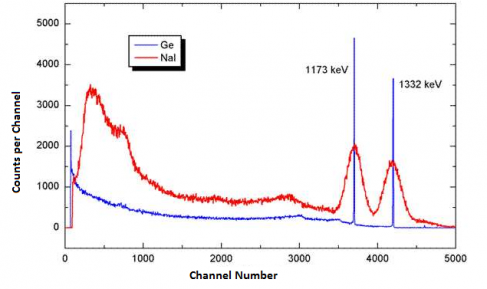Introduction
A Geiger-Müller counter can be used to measure gamma radiation. It shows the number of measured gamma quanta, but has no detailed information about the radiation. In addition the counting efficiency is very low for gamma radiation.Since gamma transitions in a nucleus have characteristic energies, it is interesting to use a detector which is able to register both the amount of incoming gammas and their corresponding energies. The gamma rays can then be graphed in a spectrum, where the number of counts is sorted within given energy intervals.
The NaI(Tl) Detector
The density and the proton number of a NaI(Tl) crystal are both relatively high (3.7 g/cm3 and 53 respectively) which makes it a very efficient gamma detector. The detector can be made in many different ways and sizes. The well detector is a popular type due to its high geometric counting efficiency. Here the crystal is formed as a cylinder where the sample can be placed.Gamma radiation excite the ions in the crystal when it is absorbed in the NaI(Tl) detector. The transition from the excited state to the ground state sends out light photons with energies proportional to the energy of the gamma. A photomultiplicator register the light photons and convert them into electric pulses. The size of a pulse is proportional to the amount of light emitted.
The Germanium detector
Germanium is particularly suitable for detection of gamma radiation because of its semiconductor properties. In a semiconductor the energy gap between the conductive and the valence bond is small, while in an insulator the energy gap is large. For instance the energy gap in a diamond is 5.33 eV and therefore a good insulator. In contrast the energy gap in germanium is 0.67 eV and it is a good semiconductor.A hole in the valance shell is created when a bound electron is excited to the conductive bond. In the presence of an electric potential, the electrons in the conductive bond will move towards the positive pole. Meanwhile the holes are successively filled by electrons, and therefore it moves towards the negative pole. The movement of the holes and the electrons will together lead to a pulse of electricity through the crystal.
 |
|---|
| Fig 1: Comparison of the spectrum of 60Co between a NaI detector and a HPGe detector |
When 60Co disintegrates emission of gamma radiation with 1173 keV and 1332 keV follows and as can be seen above the difference between the two detectors are quite large. It is much easier to identify the peaks with a Ge-detector than with a NaI- detector and we say it has a higher resolution. In practice it means the Ge detector is superior when it comes to detection of many different gamma energies, especially energies who are similar to each other. Normally a detectors resolution is measured by the full width at half maximum, FWHM, from one of the photo peaks. In the example above the FWHM is 70 keV with the NaI-detector and 2 keV with the Ge-detector.